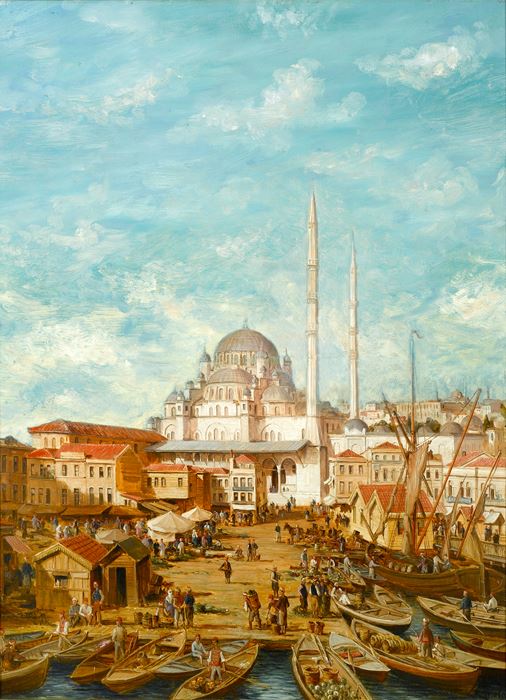Description & Technical information
In this wonderful depiction of nineteenth-century Constantinople, the Yeni Cami Mosque stands majestically, its minarets stretching upwards towards the billowing clouds, the peace and tranquillity of the skyline contrasted by the hustle and bustle of the merchants below, who one by one dock and unload their goods for trading in the Eminönü Bazaar. Robert Charles Gustave Laurens Mols has allocated much of the painted surface to the depiction of the sky, with the result that the height of the mosque’s minarets seems exaggerated. At the same time, the fanning out of the boats in a semi circular fashion around the harbour also creates a sense of width within the painting. This pull, both upwards and sideways, creates a powerful and enveloping panorama. Mols has created a scene full of drama, which captures not only the historical grandeur of the city, but also evokes the hectic atmosphere of the bazaar.
When compared to a contemporary photograph, it is evident that Mols placed emphasis on accuracy, not only in terms of the topography, but also in terms of the atmosphere and nature of the bazaar. It seems likely that Mols captured the scene early in the day, as the foreground is not heaving with figures, to the extent it does in the photograph. Moreover, many of the figures are in the boats themselves, suggesting that they are in the process of bringing goods to market.
Construction on the Yeni Cami Mosque, one of Istabul’s most famous sights, began in 1597 on the orders of Safiye Sultan (c.1550-c.1603), wife of Sultan Murad III (1546-1595). The project was hampered by political discontent, not only because of the massive expenditure, but also because the area was dominated by the city’s Jewish population, and so by displacing them with her project, Safiye Sultan hoped to curb their commercial dominance. Eventually the mosque was inaugurated in 1665, and it remains a magnificent architectural sight, covered in a pyramidal arrangement of sixty-six domes. The Eminönü distract is the historical centre of Istanbul, containing the Topkapi Palace, the Blue Mosque and Hagia Sophia, in ddition to the Yeni Cami Mosque. Due to its position on the Golden Horn, it was also a commercial hub, a characteristic captured by Mols in the present work. On the right-hand side of the present work one can see the very edge of the famous Galata bridge, which crossed the Golden Horn, and captured the imagination of many nineteenth-century writers and artists.
Mols was the son of the genre painter Florent Mols (1811-1896), and was a student at the Antwerp Academy. He was something of a prodigy, holding his first exhibition at the age of fifteen, before moving to France shortly after his seventeenth birthday. He came into contact with the artist of the Barbizon School and didn’t return to Antwerp until 1870, by which time he had built up a considerable reputation. He work is dominated by seascapes and panoramic scenes of ports. He travelled widely, depicting many of Europe’s famous cities. It seems his trip to Constantinople was a short one, as very few works from this period are known. A measure of his success and renown can be gauged from the letters of Vincent van Gogh, who not only writes admiringly of ‘the most beautiful, quiet lines and those effects that Mols...often gets’, but who also talks excitedly when given the opportunity to show a work alongside one of Mols’.¹ Yeni Cami Mosque captures many of the qualities for which Mols is known, but also has a vibrancy that one does not associate with his scenes of Western Europe.
¹ Letters from Vincent van Gogh to his brother Theo, dated 28 November 1885 and 6 December 1885.
Period: 1850-1900, 19th century
Origin: Belgium
Medium: Oil on panel
Signature: Signed ‘R. Mols’ (lower right)
Dimensions: 56 x 43.5 cm (22 x 17¹/₈ inches)
Exhibitions: Exposition Internationale des Beaux-Arts de Monte Carlo.
Categories: Paintings, Drawings & Prints

Discover the gallery
Sphinx Fine Art
Old Master & Russian Paintings
More Works From This Gallery
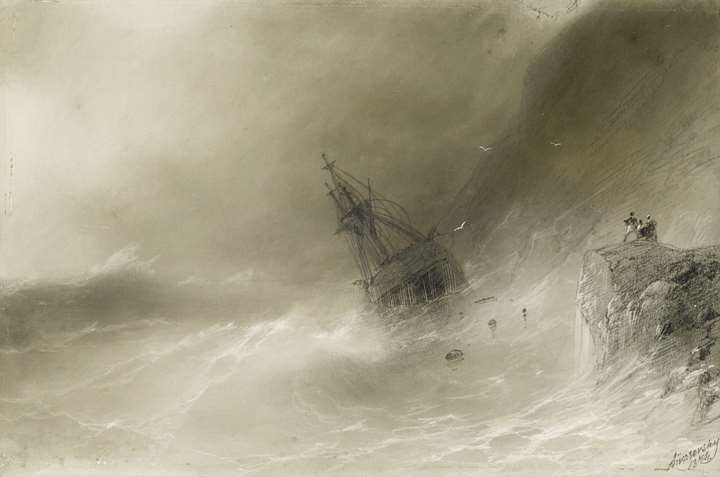
Sphinx Fine Art
Shipwreck
Ivan Konstantinovich Aivazovsky (Feodosija , 1817 - Feodosija , 1900)
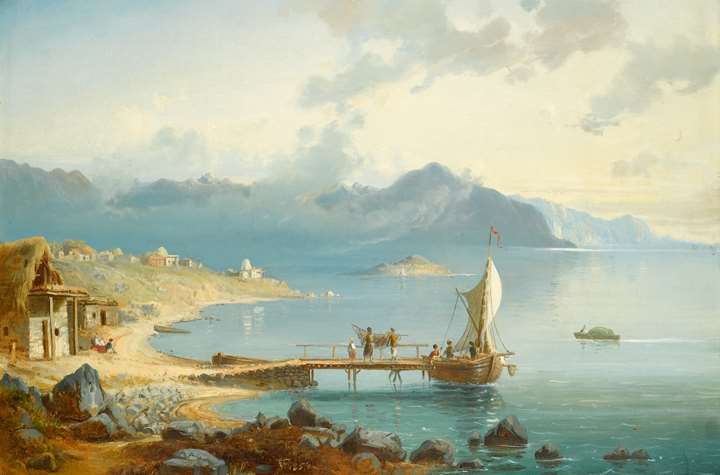
Sphinx Fine Art
A Landscape with a View over the Black Sea
Paul von Franken (Bad Godesberg, 1818 - Dusseldorf, 1884)
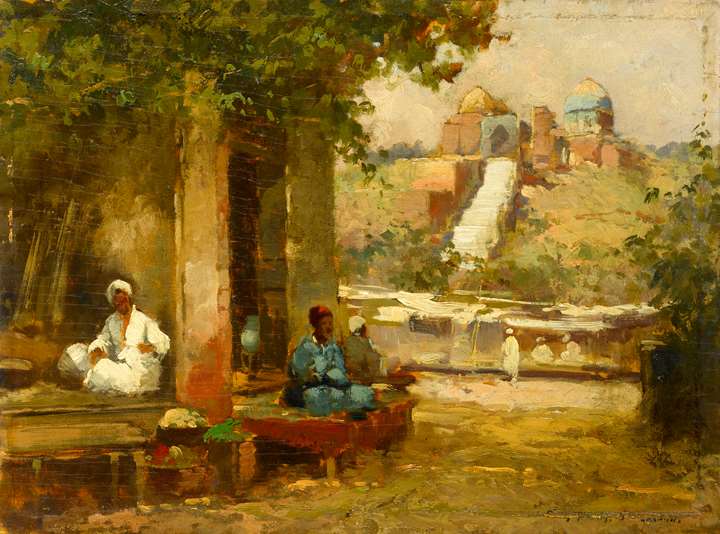
Sphinx Fine Art
Before Shah-i-Zinda, Samarkand
Padly Aladar (Budapest, 1881 - Veresegyhaza, 1949)

Sphinx Fine Art
Ice Fair on the Neva River, St. Petersburg
Joseph Josefovich Charlemagne (St. Petersburg, 1824 - St. Petersburg, 1870)
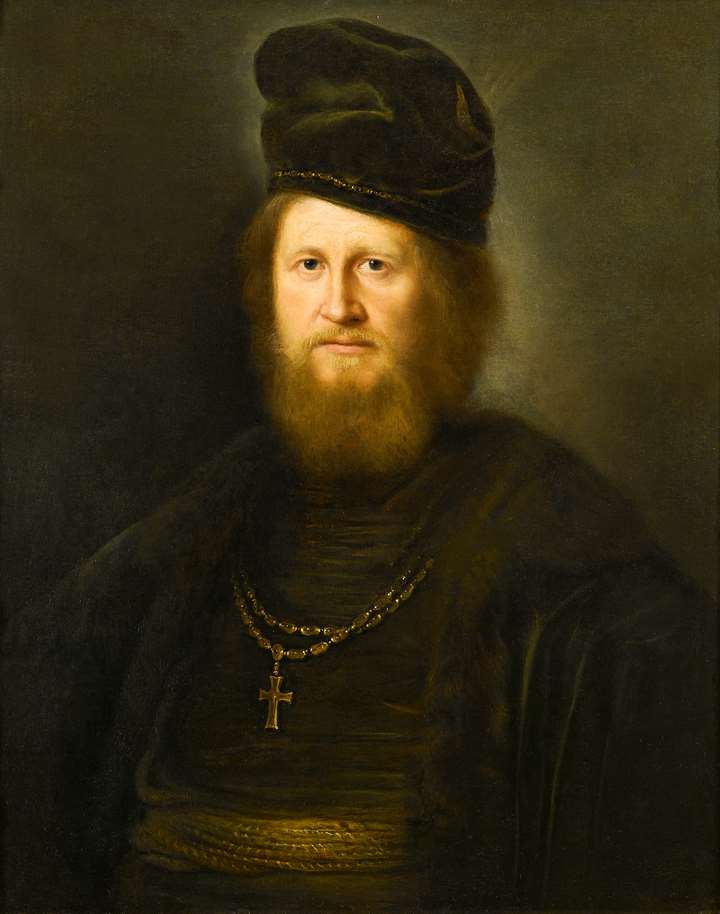
Sphinx Fine Art
Portrait of a Bearded Cleric
Helmich von Tweenhuysen II (Amsterdam c., 1604 - Gdańsk, 1673)
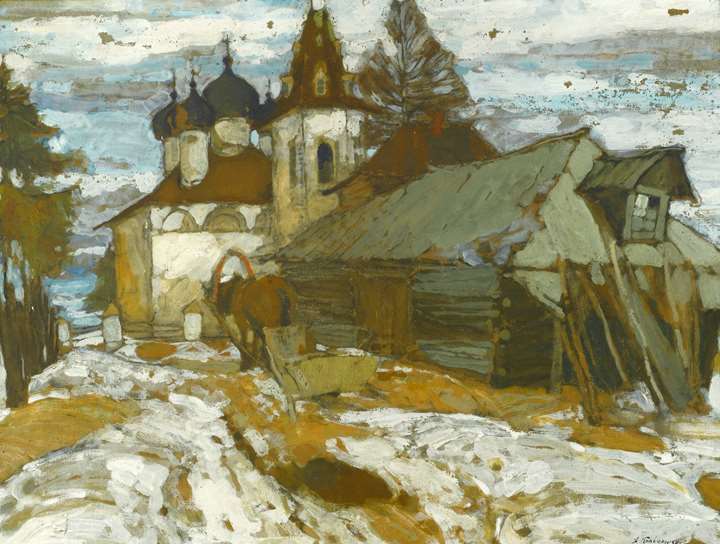
Sphinx Fine Art
Russian Village in the Winter
Aleksey Ilyich Kravchenko (Pokrovskaya sloboda [now Engels], Saratov region, 1889 - Moscow, 1940)

